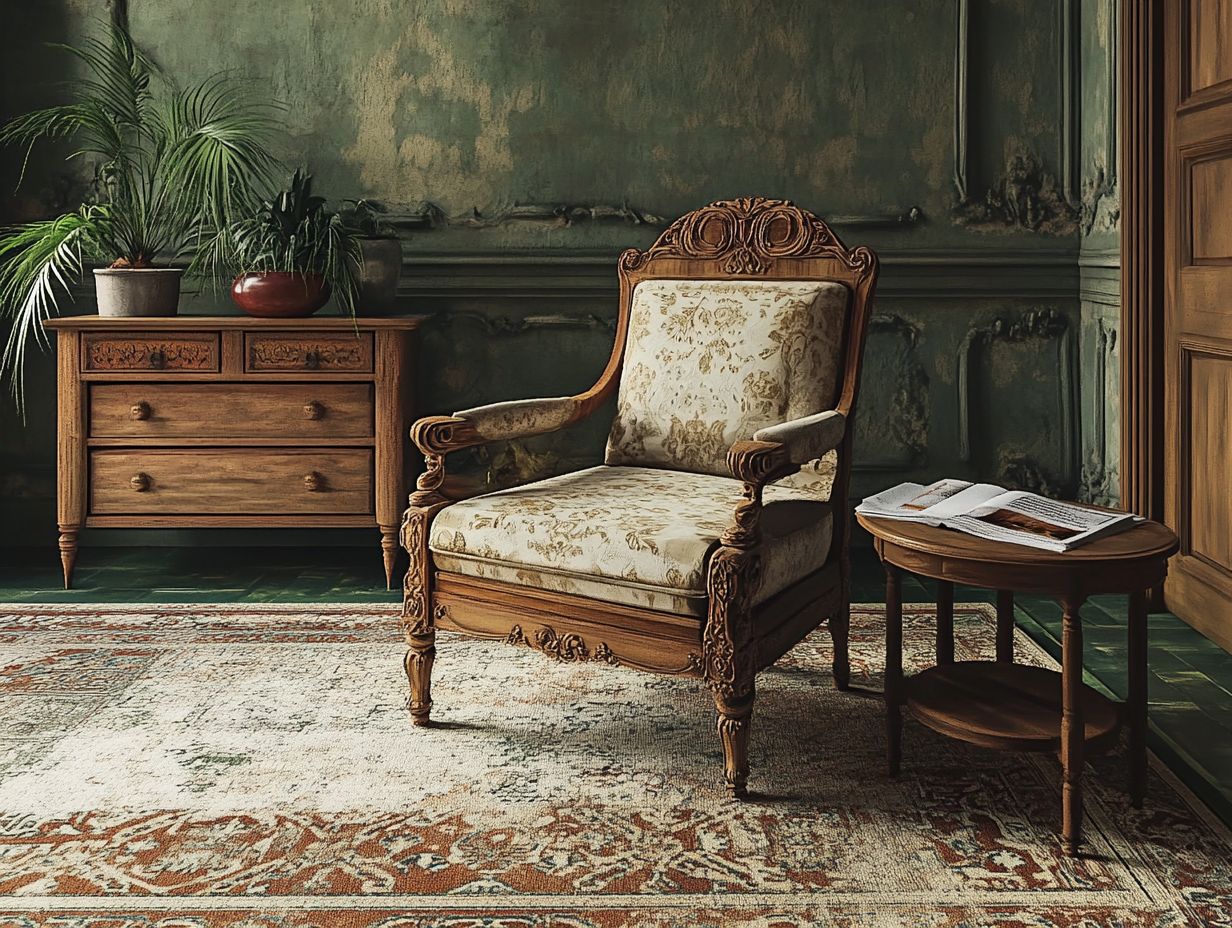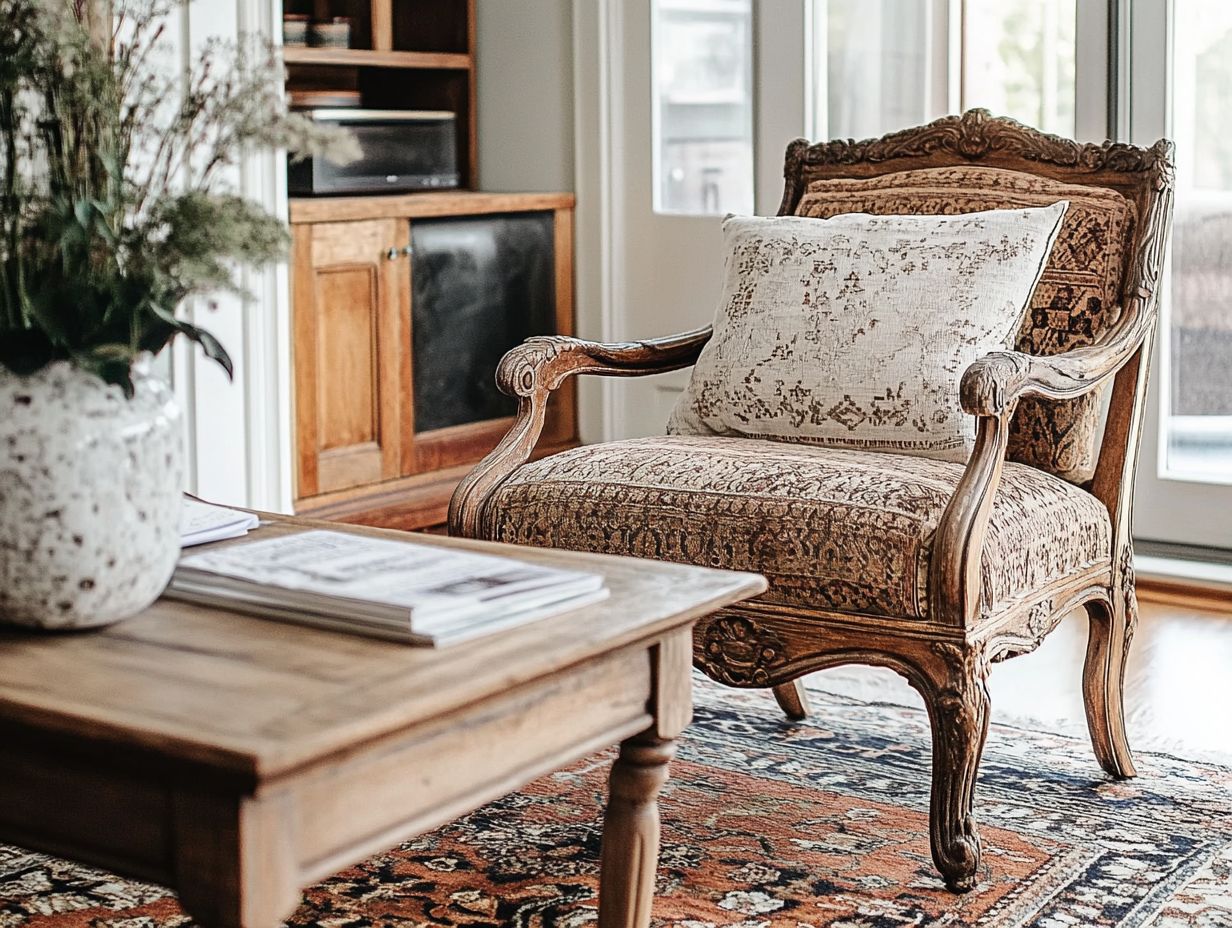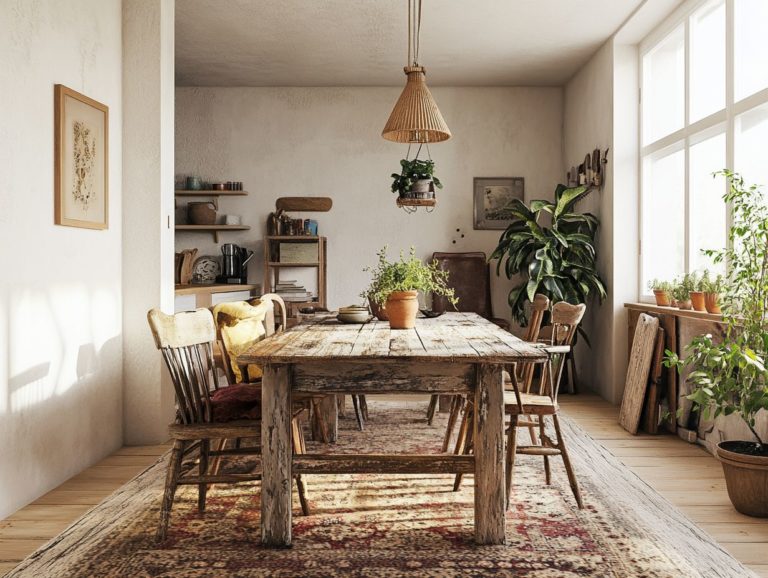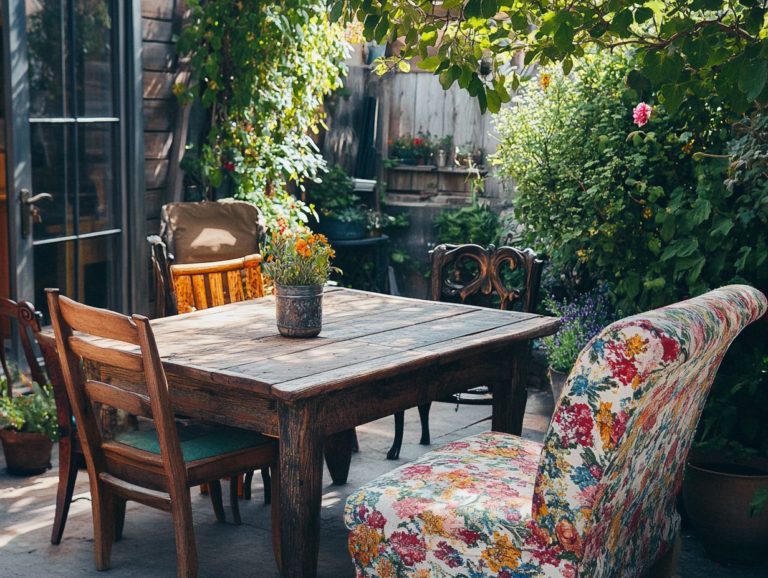The Essential Guide to Vintage Furniture Care
Get ready to dive into the fascinating world of vintage furniture! Vintage furniture exudes a unique charm, effortlessly blending history and artistry, making it a cherished choice for many homes.
This guide invites you to explore the captivating world of vintage pieces, beginning with an understanding of the materials involved, including the various types of wood and finishes that define them.
You’ll encounter common issues like wear and tear, along with effective cleaning and maintenance tips to help you preserve these treasures. Plus, you ll learn when and how to restore them to their former glory.
Discover innovative ways to integrate vintage furniture into modern decor, ensuring these timeless pieces continue to shine in your home for years to come.
Contents
- Key Takeaways:
- Understanding the Materials
- Common Issues with Vintage Furniture
- Cleaning and Maintenance Techniques
- Restoration and Repair
- Tips for Displaying and Using Vintage Furniture
- Frequently Asked Questions
- What is the importance of caring for vintage furniture?
- What are some common types of damage to vintage furniture?
- How should I clean vintage furniture?
- How can I prevent further damage to my vintage furniture?
- Should I attempt to repair any damage to my vintage furniture myself?
- How can I store my vintage furniture properly?
Key Takeaways:

- Understanding vintage materials is essential for maintaining and preserving furniture.
- Cleaning and maintenance techniques should be tailored to the specific material of the vintage furniture.
- Knowing when and how to restore vintage furniture can prolong its lifespan and maintain its value.
What is Vintage Furniture?
Vintage furniture includes pieces that are at least 20 years old but under 100, showcasing unique craftsmanship that reflects various design eras. These items are not merely functional; they carry historical value and cultural significance, appealing to those who appreciate both beauty and craftsmanship.
Often, vintage pieces embody a distinctive style that mirrors the trends and societal values of their time. Styles can range from mid-century modern to art deco designs. Unlike antique furniture, which generally exceeds 100 years and is rooted in a different historical context, vintage items allow you to weave a touch of nostalgia into your space while enjoying modern functionality.
Their unique features, such as intricate detailing and high-quality materials, resonate with individuals who value craftsmanship and strive to make a statement in their home decor. This blend of history and style enhances the aesthetic appeal of your environment and invites rich conversations about the past, elevating the overall ambiance of your home.
Understanding the Materials
Grasping the materials that comprise vintage furniture is essential for its care and maintenance. Each type of wood and finish demands specific cleaning supplies and techniques that are uniquely suited to their characteristics.
Identifying Types of Wood and Finishes
Identifying the types of wood and finishes in vintage furniture is crucial for preserving its aesthetic appeal and longevity. Different woods like oak, cherry, and mahogany each possess unique grains and characteristics that demand attention.
Understanding the specific finishes whether oil, wax, or varnish (a clear finish that protects wood surfaces) greatly influences how you should approach cleaning and conservation. For example, oak, with its prominent open grain, typically requires gentle cleaning methods to avoid damage.
In contrast, cherry wood, celebrated for its rich, reddish hue, benefits from regular dusting and a thoughtful application of wood polish to enhance its natural luster, using soft cloths for best results.
Mahogany, with its fine, straight grain and darker finish, requires special care to prevent dullness and scratching. By following the appropriate cleaning instructions tailored to these woods, you ensure that the furniture not only retains its charm but may also appreciate in value over time.
Common Issues with Vintage Furniture
You may face several common issues that can affect its charm and functionality. Damage from age and use think scratches, dents, and even mildew growth can significantly compromise its aesthetic allure and structural integrity if not addressed in a timely manner. Act quickly to avoid further damage!
It’s essential to pay attention to these details to preserve the beauty and longevity of your cherished pieces.
Damage and Wear from Age and Use

The damage and wear observed in vintage pieces can arise from various factors, including environmental conditions, issues with moisture levels, and regular use. It’s essential to conduct careful furniture inspections and adopt appropriate care methods.
As time passes, you may notice wood warping, peeling veneers, and fading or worn fabric. These are clear signals that restoration is necessary. To tackle these concerns, consider using specialized cleaning solutions tailored for different materials.
For example, gentle wood cleaners can preserve the integrity of wooden surfaces, while fabric protectants prolong the life of upholstered furniture.
Regular inspections are crucial for spotting early signs of damage. This lets you take quick action before small issues grow into costly repairs.
By applying the right care techniques, your vintage treasures can retain their charm and longevity for years to come.
Cleaning and Maintenance Techniques
Effective cleaning and maintenance techniques are crucial for preserving the beauty and functionality of your vintage furniture.
Whether you use gentle cleaning methods with oil soap or tackle tough stains with vinegar solutions, each approach plays a vital role in protecting your treasured pieces.
Proper Cleaning Methods for Different Materials
Proper cleaning methods for the various materials used in vintage furniture can differ dramatically. Use cotton cloths, furniture polish, and protective gloves to ensure that your cleaning solution doesn t harm the wood finish.
For fabric upholstery, a gentle brush or vacuum is your best friend. This helps prevent dust buildup without risking any damage.
For delicate fabrics, a distilled water approach paired with suitable fabric cleaners is essential to maintain their integrity. Understanding the unique characteristics of each material is vital.
Using the wrong cleaning solution could lead to discoloration or deterioration.
To keep your furniture looking great, consider applying protective measures like fabric protectants and wood wax. Additionally, it’s important to understand what you should know before buying vintage furniture. These steps will help maintain that vintage charm while ensuring your pieces stand the test of time.
Preserving and Protecting Vintage Furniture
Preserving and protecting vintage furniture requires applying a wax coating and other protective topcoats. These shield against UV rays and environmental factors that can lead to deterioration.
Alongside these techniques, you should also consider using specialized UV protection films or coatings. They can significantly minimize light damage over time.
Many enthusiasts recommend establishing a regular maintenance routine. Dusting with soft cloths prevents scratches, and maintaining stable humidity and temperature levels is crucial.
Incorporating a routine of oiling wooden surfaces can enhance their natural luster and add a protective layer against moisture. By combining these strategies, you can effectively maintain vintage furniture.
Restoration and Repair
Restoring and repairing vintage furniture typically calls for the finesse of restoration experts. Yet, many furniture enthusiasts, like you, can embark on successful DIY projects by following specific repair tips designed for antique restoration challenges.
With a touch of patience and the right guidance, you can breathe new life into cherished pieces. Enjoy the rewarding experience of craftsmanship.
When and How to Restore Vintage Furniture

Knowing when and how to restore vintage furniture is essential for you. Improper restoration can diminish its cultural significance. It s vital to adhere to appropriate cleaning techniques and methods that honor the original craftsmanship.
Understanding the age and history of your piece will guide you in deciding whether restoration is necessary or if preservation is a more suitable option. Key factors to consider include the extent of damage, the original materials used, and the item s historical value.
Minor scratches can often be addressed with gentle cleaning methods that preserve the integrity of the finish. Significant structural issues may call for more invasive techniques, like re-gluing joints or replacing missing parts, ideally sourced from similar vintage materials.
Hiring a skilled conservator is a smart choice. This ensures that your restoration efforts respect the piece s history, retaining its beauty while safeguarding its story.
DIY Repair Tips
Engaging in DIY repair for vintage furniture not only saves you money but also offers a fulfilling experience. You ll love how easy it is to tap into effective cleaning tips and maintenance strategies from furniture restorers.
With the right approach, you can breathe new life into your cherished pieces, whether it’s an antique cabinet or a mid-century chair. Common issues like scratched surfaces, loose joints, or faded finishes can often be addressed with simple tools and materials you can easily find at your local hardware store. Additionally, if you’re looking for tips for finding affordable vintage furniture, there are plenty of resources available to help you on your quest.
A mixture of olive oil and vinegar is a fantastic way to rejuvenate wood finishes while protecting against future wear and tear. Regular dusting and applying a suitable wax can prevent buildup and keep your stunning items looking their best for years to come.
By embracing these practical repair and maintenance techniques, you can enjoy your timeless furniture and preserve the rich history they add to your home. For more insights, check out what to look for when buying vintage furniture. Start your vintage restoration journey today!
Tips for Displaying and Using Vintage Furniture
Incorporating vintage furniture into your home decor requires a refined understanding of how to blend these timeless pieces seamlessly into your space. You ll love how easy it is to showcase their charm while ensuring they remain in pristine condition.
Mastering effective furniture care techniques and preservation strategies will elevate your decor while safeguarding the integrity of your vintage treasures.
How to Incorporate Vintage Pieces into Modern Decor
Incorporating vintage pieces into your modern decor can create a truly unique aesthetic. This balances timeless craftsmanship with contemporary styles that cater to your discerning taste as a furniture enthusiast.
To achieve this harmonious blend, start with a neutral color palette that allows your vintage furniture to shine without overwhelming the space. Mixing textures is another key element imagine pairing a sleek leather sofa with a rustic wooden coffee table; it can elevate the overall design beautifully.
Don t forget to use modern accessories, like minimalist artwork or contemporary lighting, to bridge the gap between eras while showcasing the unique charm of your vintage finds. Maintaining a consistent scale is essential, ensuring that every piece, whether vintage or modern, works together cohesively to create an inviting atmosphere celebrating both nostalgia and innovation.
Frequently Asked Questions
What is the importance of caring for vintage furniture?

Vintage furniture is not only a valuable and unique addition to your home but also holds historical and sentimental value. Proper care can help preserve its beauty and functionality for years to come.
What are some common types of damage to vintage furniture?
- Scratches
- Water damage
- Fading
- Wood warping
These can be caused by improper handling, exposure to sunlight or moisture, and age.
How should I clean vintage furniture?
The best way to clean vintage furniture is to use a soft, damp cloth and mild soap.
Avoid harsh chemicals or rough materials that can damage the delicate wood and finishes. Always test a small, inconspicuous area first!
How can I prevent further damage to my vintage furniture?
Keep your vintage furniture safe! Keep it away from direct sunlight and heat or moisture sources.
Use coasters and placemats to protect surfaces from spills and scratches. Regular dusting and polishing will keep it looking its best!
Should I attempt to repair any damage to my vintage furniture myself?
Unless you’re experienced in vintage furniture restoration, leave repairs to the professionals.
DIY repairs can often cause more harm than good, possibly decreasing the value of your piece!
How can I store my vintage furniture properly?
If you need to store your vintage furniture, clean it thoroughly first.
Wrap it in acid-free paper or cloth and store it in a dry, climate-controlled area to prevent damage from humidity or temperature fluctuations.





